- VMware
- VMware vCenter Server (VCSA), VMware vSphere
- 26 June 2024 at 07:27 UTC
-

- 1/2
One of the advantages of VMware vCenter Server is that you can more easily monitor your hosts, as well as your virtual machines.
Indeed, you can see everything in one place and you can even create your own alarms to receive a warning or an error based on one or more conditions that you have defined beforehand.
- Add a new alarm definition
- List of triggered alarms
- Recognize an alarm
- Reset an alarm to green
- Delete an alarm definition
1. Add a new alarm definition
To get started, select your VMware vCenter Server on the left, then go to the "Configure" tab.
Then go to the "More -> Alarm Definitions" section to see the list of alarms already set on it.
Click: Add.
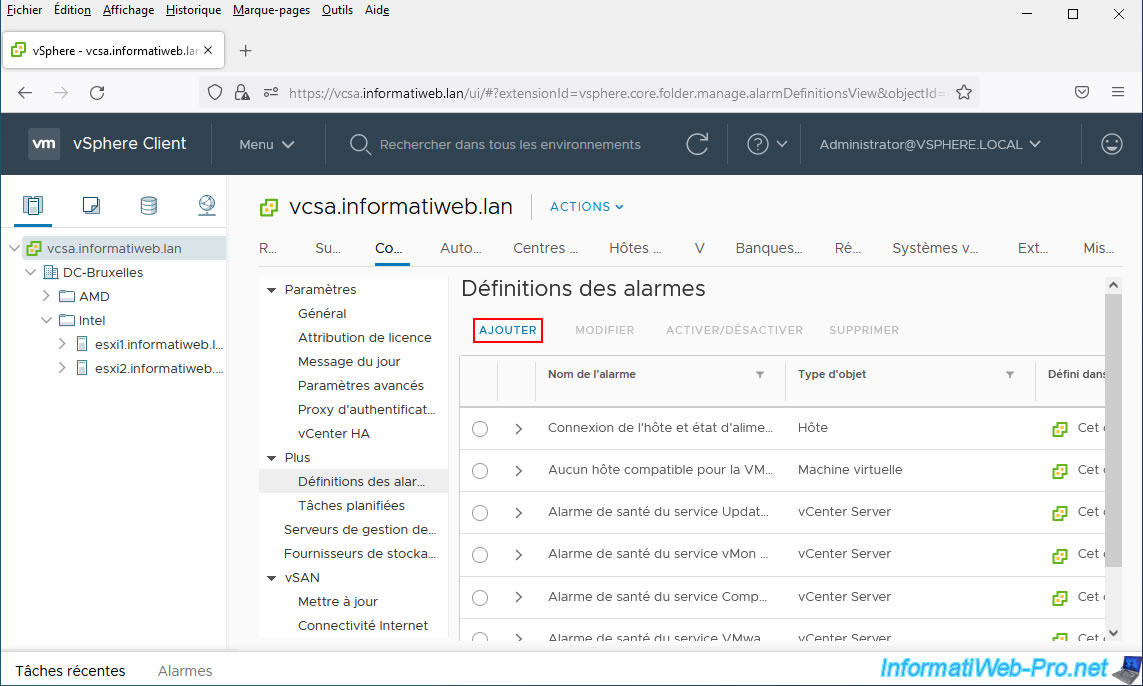
To add a new alarm, you can also right-click "Alarms -> New Alarm Definition" on your VMware vCenter Server.
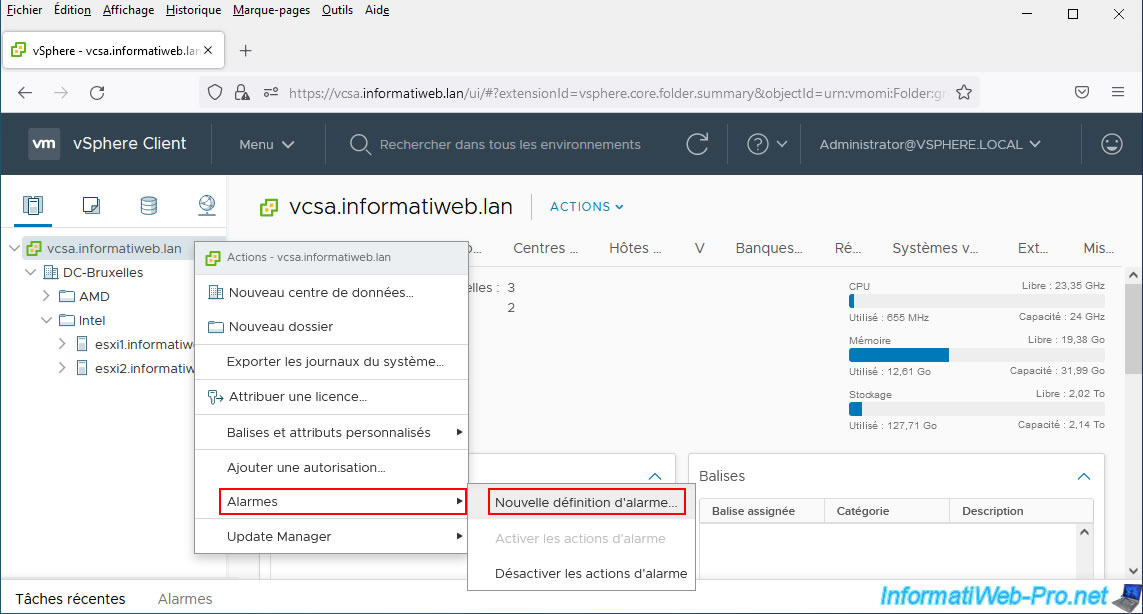
The "New Alarm Definition" wizard appears and will ask you to specify:
- Alarm Name: a name for it. This will appear when it has been triggered by your server according to the conditions you define for it.
- Description: an optional description for this one.
- Target type: what type of object do you want to monitor. Indeed, from one object (host, virtual machine, ...) to another, the conditions will obviously not be the same.
- Targets: the object(s) which will be affected by this alarm.
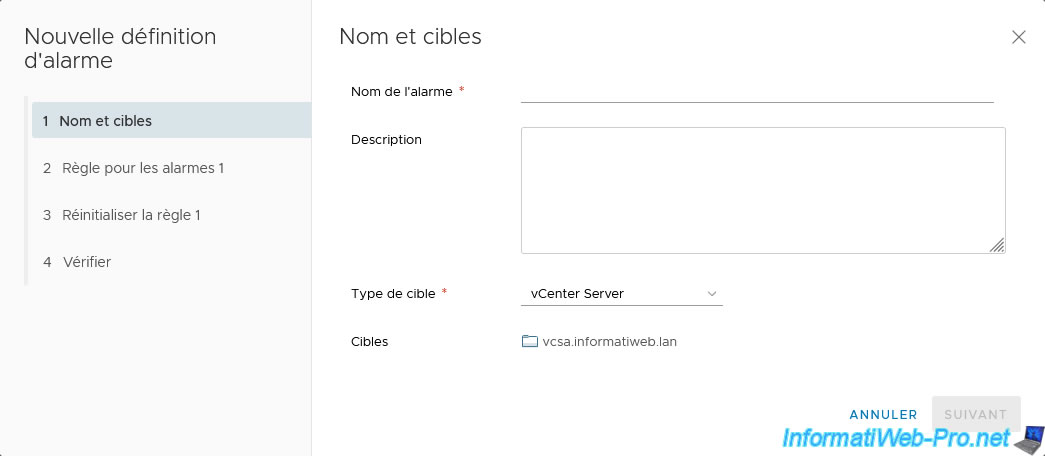
For the type of target, you will have the choice between:
- Virtual Machines (VMs)
- Hosts (VMware ESXi)
- Clusters
- Datacenters
- Datastores
- Distributed Switches (VDS)
- Distributed Port Groups
- Datastore Clusters
- vCenter Server
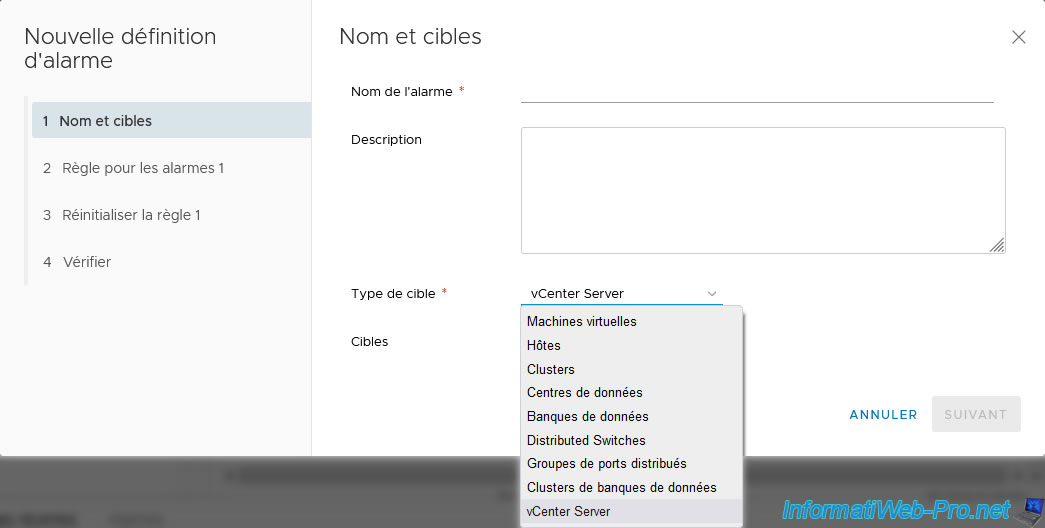
For this tutorial, we will create an alarm to monitor RAM usage on our VMware ESXi hypervisors (hosts).
If the percentage of RAM remaining on a host is less than 25%, VMware vCenter Server should show us a warning.
For this, we indicated:
- Alarm Name: low Remaining RAM.
- Description: Percentage of RAM remaining on a host less than 25%.
- Target type: Hosts.
- Targets: All Hosts on vcsa.informatiweb.lan (2).
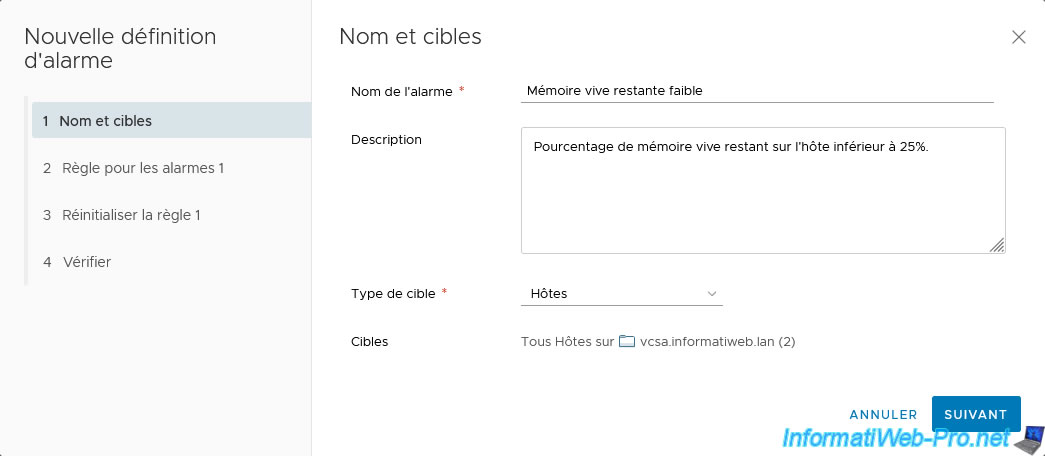
Next, you will need to configure the conditions that will allow VMware vCenter Server to trigger this alarm based on the parameters you want to check in real time.

For this example, we want to monitor the RAM usage of our VMware ESXi hosts.
So, we search for the keyword "memory" and VMware vCenter Server displays the condition: Host Memory Usage.

For this condition, you can choose between "is above" or "is below".
In our case, we choose "is above".

We indicate "75" for the percentage of host memory usage and "30 sec" for the minimum time during which this condition must be true for the alarm to be triggered.
This will trigger the alarm fairly quickly (given that this is a simple test for a tutorial). In production, you will select a larger value for this type of condition.

This alarm will therefore be triggered by VMware vCenter Server if host memory usage is greater than 75% for at least 30 seconds.

Next, you will need to choose how your VMware vCenter Server should trigger the alarm.
As you can see, you can display this as a warning or as critical.
This also means that you could create 2 similar alarms with 2 different values so that the 1st alarm displays a warning and the 2nd displays later with a critical state if you get even closer to the critical threshold.
In our case, we could for example display a warning when the host's RAM usage rate is greater than 75% and a critical state if it is greater than 90%.

When an alarm is triggered by your VMware vCenter Server, you will have the option to:
- Send email notifications. : allows you to be scheduled quickly by email without having to regularly connect to your VMware vCenter Server.
- Send SNMP traps: allows you to receive notifications using the SNMP protocol.
- Run script: Allows you to automatically run a script when this alarm is triggered.
To add other actions, click: Add advanced actions.

The advanced actions available when an alarm is triggered are:
- Enter maintenance mode
- Enter standby
- Exit maintenance mode
- Exit standby
- Reboot host
- Shutdown host

Then click Next.

If the condition is no longer true, VMware vCenter Server will automatically reset this alarm to "green" (Normal).
Which means that it will automatically disappear when it is reset by vCenter Server.
However, you will still be able to see the alarm triggering in the event lists.
When resetting this alarm to Normal, you will be able to perform the same actions again (sending email notifications, SNMP traps, ...) as before.
Click Next.

A summary of your alarm configuration appears with:
- Alarm Name: its name
- Description: its description (optional)
- Targets: what is targeted (monitored) by this alarm definition
- Alarm Rules: the condition(s) that must be checked to know when to trigger this alarm
- Reset Rules: If the condition(s) of this alarm are no longer met, the alarm will automatically reset to "green" (normal).
By default, this alarm will be activated directly after it is added.
If you do not want to use this alarm at this time, turn off the "Enable this alarm" option.
Next, click Create.

The new alarm definition appears in the list of alarm definitions of your VMware vCenter Server where we added it.
Note that the "Add", "Edit", "Disable", and "Delete" options are usable here, because this alarm was set on this vCenter Server object (vcsa.informatiweb.lan).

On the other hand, if you display the list of alarm definitions for one of your hosts (which are affected by this alarm), you will see that you will not be able to modify, disable or delete it.
Indeed, it is visible here, because your host is affected by it, but it cannot be modified here, because it has been defined on a parent object or not on the current object.

Share this tutorial
To see also
-

VMware 7/27/2022
VMware ESXi 7.0 / 6.7 - Add a physical disk to host
-

VMware 7/20/2022
VMware ESXi 7.0 / 6.7 - Change the identifier (UUID) of a virtual hard disk (VMDK)
-

VMware 7/13/2022
VMware ESXi 7.0 / 6.7 - Create a virtual USB key
-

VMware 6/13/2024
VMware vSphere 6.7 - Configure Virtual Flash (SSD cache)


You must be logged in to post a comment